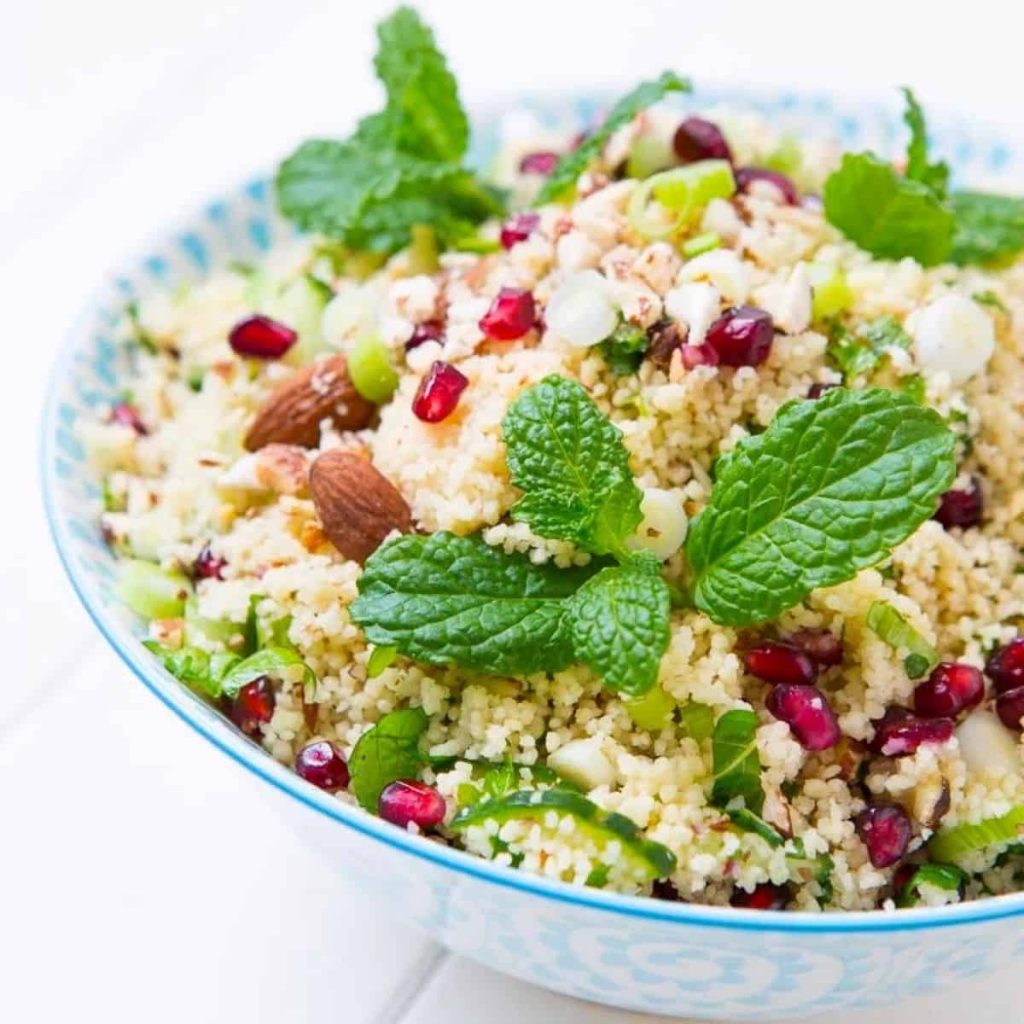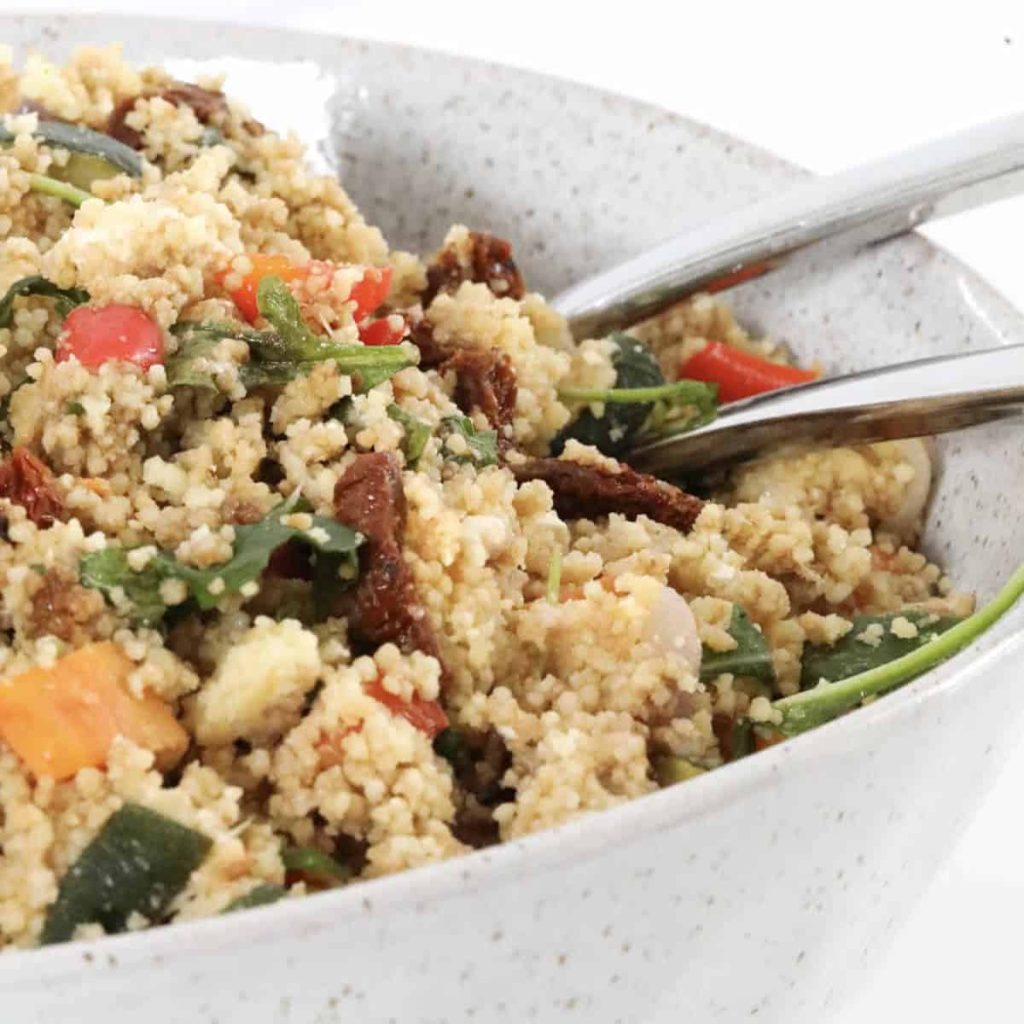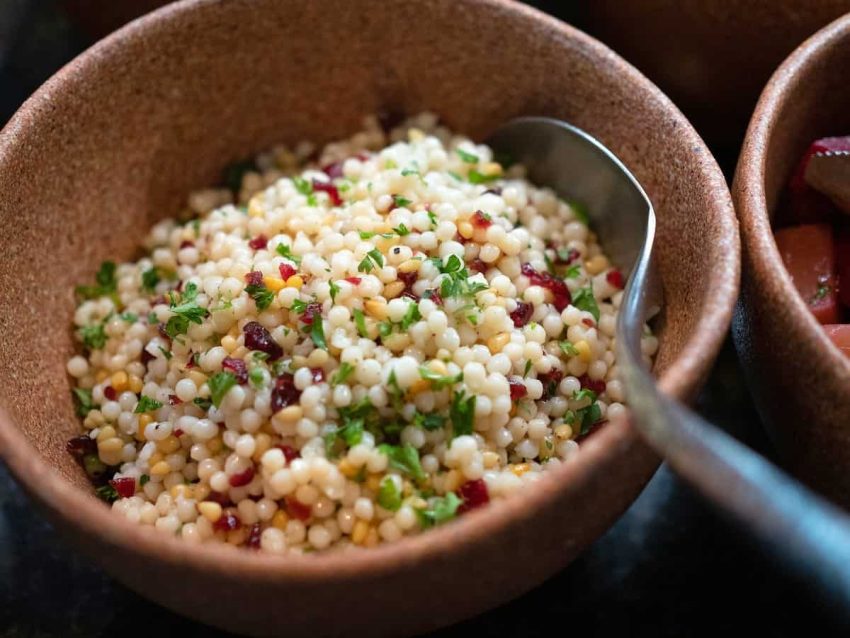You can keep cooked couscous in the fridge for approximately 4 to 6 days. The exact duration depends on factors such as the ingredients used, initial food quality, and proper storage methods.
To maximize shelf life, store the couscous in airtight containers, ensuring they are sealed tightly to prevent moisture from entering. Label the containers with the storage date for easy tracking. If you have more couscous than you can consume within a week, freezing is an option.
Portion it, use freezer bags and thaw it in the fridge for gradual defrosting. Proper storage and handling practices will help maintain the couscous’s freshness, taste, and safety within this time frame.
What Are the Different Types of Couscous?

Couscous comes in several types, each with its unique characteristics and uses. Here are some common types of couscous
Regular Couscous: This is the most common type and is often labeled as “traditional” or “Moroccan” couscous. It’s made from durum wheat semolina, which is moistened and rolled into tiny granules. Regular couscous is quick-cooking and very versatile, making it a popular choice for various dishes.
Israeli (Pearl) Couscous: Also known as “ptitim” or “Jerusalem couscous,” this type of couscous consists of larger, pearl-sized granules. It has a slightly chewier texture than regular couscous. Israeli couscous is often used in salads, side dishes, or as a base for more substantial meals.
Whole Wheat Couscous: Whole wheat couscous is made from whole wheat semolina, providing more fiber and a nuttier flavor compared to regular couscous. It’s a healthier alternative and can be used in a variety of recipes.
Tri-Color Couscous: This couscous is a blend of regular, whole wheat, and spinach or tomato-flavored couscous, creating a colorful and flavorful mix. Tri-color couscous is excellent for adding visual appeal to salads and side dishes.
Moghrabieh (Lebanese Couscous): Moghrabieh is larger and denser than regular couscous, with a distinct chewy texture. It’s often used in Middle Eastern dishes, particularly in Lebanon, where it’s a key ingredient in dishes like Moghrabieh stew.
Maftoul (Palestinian Couscous): Maftoul is a traditional Palestinian couscous made from whole wheat. It’s larger and coarser than regular couscous, often used in Palestinian dishes like Maftoul with chicken or vegetables.
Instant Couscous: This couscous type is precooked and then dried. It’s the fastest to prepare, requiring only hot water or minimal cooking. Instant couscous is ideal for quick meals or when you need couscous in a hurry.
How To Store Couscous?
Couscous, a versatile grain, has become a kitchen staple for many. It’s quick to cook and can be a great addition to various dishes. However, once you’ve prepared couscous, you might wonder about the best way to store it for future use. Storing couscous properly is crucial to maintaining its freshness and flavor.
Storing Dry Couscous
First and foremost, when you purchase couscous from the store, it often comes in a resealable bag. If not, transfer it to an airtight container. Airtight containers prevent air and moisture from getting in, keeping the couscous fresh.
Also, make sure the container’s lid seals tightly. A secure seal is crucial in preventing moisture from entering the couscous, which can cause it to become clumpy or spoiled.
It’s a good practice to label the container with the type of couscous (e.g., regular, whole wheat, or tri-color) and the date of storage. This helps you keep track of its freshness and identify different types of couscous in your pantry.
In addition, store your dry couscous in a cool, dry pantry or cupboard. Exposure to heat, light, and humidity can compromise its quality. Keep it away from the stove, oven, or any other heat source.
However, try to maintain a consistent temperature where you store your couscous. The best temperature for storage falls within the range of 50 to 60 degrees Fahrenheit. Temperature fluctuations can cause condensation inside the container, which is not ideal.
Storing Cooked Couscous
If you’ve cooked more couscous than you can consume in one sitting, store the leftovers in airtight containers. Cooked couscous should be refrigerated promptly.
Secondly, allow the cooked couscous to cool to room temperature before refrigerating it. Putting hot couscous in the fridge can raise its internal temperature, potentially impacting other foods’ safety.
To keep cooked couscous fresh, the refrigerator is your friend. The perfect temperature for this is around 35 to 40 degrees Fahrenheit. Remember, it’s not safe to leave cooked couscous at room temperature, as it can make it more prone to foodborne issues.
Furthermore, consider portioning your cooked couscous into servings before storing it. This makes it more convenient to grab the amount you need for a meal without reheating the entire batch.
As with dry couscous, label the containers with the date of storage. This helps you keep track of when it was prepared.
Cooked couscous can generally remain fresh in the fridge for about 4 to 6 days when stored properly. Beyond this time frame, its quality may decline, and it could become unsafe to eat.
Freezing Cooked Couscous
To extend the shelf life of cooked couscous, consider freezing it in portioned servings. Use freezer-safe bags or containers. Squeeze out excess air from the bags to prevent freezer burn.
As always, label the containers or bags with the date of freezing to help you keep track of how long they’ve been in the freezer.
When you’re ready to use frozen cooked couscous, transfer it to the refrigerator for gradual defrosting. Avoid thawing it at room temperature or in the microwave, as this can lead to overcooking.
By following these storage guidelines, you can enjoy couscous that retains its freshness and taste, whether it’s dry couscous for future cooking or cooked couscous for quick, convenient meals. Proper storage practices ensure that your couscous remains a valuable ingredient in your kitchen.
Is My Couscous Still Good to Eat? How to Detect Spoilage
Recognizing when couscous has gone bad is important for your safety and enjoyment. Here are some signs to tell if couscous is no longer good
Off Odors
One of the first and most noticeable indicators of spoiled couscous is an unusual or off-putting odor. Fresh couscous should have a mild, neutral scent. If you detect a sour, rancid, or generally unpleasant smell when you open the container, it’s a clear sign that the couscous has gone bad. It’s best not to use it in your recipes.
Texture Changes
Spoiled couscous often undergoes significant changes in texture. While fresh couscous is typically light, fluffy, and separates easily, spoiled couscous may become clumpy, sticky, or hard. If you notice these textural changes when handling or cooking couscous, it’s best to discard it, as it won’t deliver the pleasant mouthfeel and taste you expect.
Unusual Color
Fresh couscous is usually pale and uniform in color. Any significant deviations from this norm can be a sign of spoilage. Discoloration, such as dark spots, off-color patches, or a generally odd appearance, is a red flag. It indicates that the couscous might have deteriorated and may not be safe to consume.
Mold or Pests
Visible signs of mold growth or the presence of tiny bugs or insects in your couscous are definite indicators that it’s time to discard it. Mold not only affects the couscous but can also produce toxins that are harmful if ingested. Similarly, pests can introduce contaminants that pose health risks.
Taste Test
If you’re still unsure after inspecting the couscous, you can perform a small taste test. However, be cautious when doing this and consider the previous signs before tasting. If the couscous tastes sour, bitter, or has a different flavor than what you’re used to, it’s wise to discard it. Trust your taste buds and prioritize your health.
Is it safe to reheat couscous?
Yes, it’s safe to reheat couscous, but you should take some precautions to ensure it remains both safe to eat and maintains its desirable texture.
Reheating on the Stovetop
To reheat couscous on the stovetop, start by placing it in a non-stick pan or skillet. Use a pan that’s large enough to spread the couscous out evenly.
Couscous tends to dry out when reheated, so it’s a good idea to add a small amount of liquid. You can use water, vegetable or chicken broth, or even a bit of olive oil. The liquid helps prevent the couscous from becoming overly dry during the reheating process.
Heat the couscous over low to medium heat. It’s essential to use gentle heat to avoid scorching or burning the couscous. Stir occasionally to ensure even heating. The couscous is ready when it’s heated through, which usually takes just a few minutes.
Reheating in the Microwave
First, place the couscous in a microwave-safe container. Make sure it’s a suitable size for the amount of couscous you’re reheating.
Whereas, couscous tends to dry out quickly in the microwave. To counter this, sprinkle a bit of water over the couscous, or cover it with a damp paper towel. The added moisture helps maintain the couscous’s texture and prevents it from becoming overly dry.
Moreover, use a medium power setting on your microwave. Start by reheating the couscous for 1-2 minutes. Remember to pause and stir it halfway through the reheating process. This helps ensure that it’s heated evenly.
Tips
- Be cautious not to overheat the couscous.. Overcooked couscous can become dry and unpalatable. It’s better to slightly underheat it and adjust as needed.
- Ensure that the reheated couscous reaches a safe internal temperature. This is typically 165°F (73.9°C) to kill any potential bacteria
- If you want to add some extra flavor, consider mixing in fresh herbs, a drizzle of olive oil, or a squeeze of lemon juice after reheating. These additions can help revive the flavors of the couscous.
How To Use Leftover Couscous In Creative Ways?

Couscous Salad
- Toss leftover couscous with fresh veggies like tomatoes, cucumbers, bell peppers, and herbs.
- Add a dressing made from olive oil, lemon juice, and your choice of herbs and spices.
- Top with feta cheese, olives, or grilled chicken for added flavor.
Stuffed Bell Peppers
- Cut the tops off bell peppers and remove the seeds and membranes.
- Mix leftover couscous with ingredients like ground meat, onions, tomatoes, and spices.
- Fill the bell peppers with the couscous mixture and bake until the peppers are tender.
Couscous Soup:
- Add leftover couscous to your favorite soup for added heartiness.
- It works well in tomato-based soups, minestrone, or vegetable soup.
- Ensure you heat the couscous thoroughly in the soup before serving.
Couscous Patties
- Mix couscous with grated vegetables like zucchini, carrots, and onions.
- Add an egg and breadcrumbs to bind the mixture, season with herbs and spices.
- Shape into patties and pan-fry until golden brown.
Couscous Breakfast Bowl
- Use leftover couscous as a base for a savory breakfast bowl.
- Top with a fried or poached egg, sautéed spinach, and a drizzle of hot sauce for a satisfying morning meal.
Couscous Stir-Fry
- Sauté leftover couscous with a mix of vegetables, like bell peppers, broccoli, and snap peas.
- Add a protein source such as tofu, shrimp, or chicken.
- Season with soy sauce and your preferred stir-fry sauce.
Mediterranean Couscous Bowl
- Combine leftover couscous with ingredients like chickpeas, diced cucumber, red onion, and cherry tomatoes.
- Drizzle with tahini sauce, sprinkle with fresh parsley and feta cheese.
Couscous and Tuna Salad
- Mix couscous with canned tuna, chopped celery, red onion, and mayonnaise.
- Season with salt, pepper, and a squeeze of lemon juice for a quick and tasty salad.
Couscous and Roasted Vegetables
- Combine couscous with roasted vegetables like sweet potatoes, carrots, and red onion.
- Add a touch of olive oil and herbs for a flavorful side dish.
Couscous Wraps
- Use large lettuce leaves, tortillas, or pita bread to create wraps.
- Fill with leftover couscous, grilled chicken, hummus, and your choice of vegetables.
FAQ
How long does couscous salad keep in the fridge?
Couscous salad typically remains fresh in the fridge for 3 to 4 days, provided it’s stored in an airtight container.
Can you eat couscous after 5 days?
It’s generally not recommended to eat couscous that has been in the fridge for 5 days or longer, as it may become unsafe or lose quality.
Why can’t you reheat couscous?
You can reheat couscous, but it may dry out if not done correctly. Use gentle heat and add a bit of moisture, like water or broth, to maintain its texture.
Is couscous a good or bad carb?
Couscous is considered a complex carbohydrate, which is generally considered a “good” carb as it provides sustained energy and is rich in fiber and nutrients.
Can couscous be eaten cold?
Yes, couscous can be eaten cold and is commonly used in cold salads. It’s refreshing and versatile when served chilled.
What are the disadvantages of couscous?
Couscous disadvantages include its high carbohydrate content, which may not be suitable for low-carb diets, and the possibility of overcooking, which can make it mushy.
Is couscous healthy for weight loss?
Couscous can be a part of a healthy diet for weight loss due to its fiber content, which helps with satiety, but portion control is important.
Can you just add boiling water to couscous?
Yes, you can add boiling water to couscous for quick preparation. Cover it and let it steam for a few minutes before fluffing with a fork for a light and fluffy texture.
Final words
To sum up, knowing how long you can keep couscous in the fridge is not just about food safety but also about enjoying its flavors and versatility. Cooked couscous typically stays fresh for about 4 to 6 days when stored correctly. By following best practices like using airtight containers and proper sealing, you can ensure it maintains its quality.
Remember, if you have couscous leftovers and you can’t finish them in time, freezing is an option to extend its shelf life. When you’re ready to use it, simply thaw it in the fridge for your next delicious meal.
Couscous is a wonderful ingredient that can add a touch of the Mediterranean to your dishes. By understanding how to store it safely, you can enjoy its delightful taste while reducing food waste. So, savor the flavor of perfectly stored couscous, and have a great culinary adventure in your kitchen!

